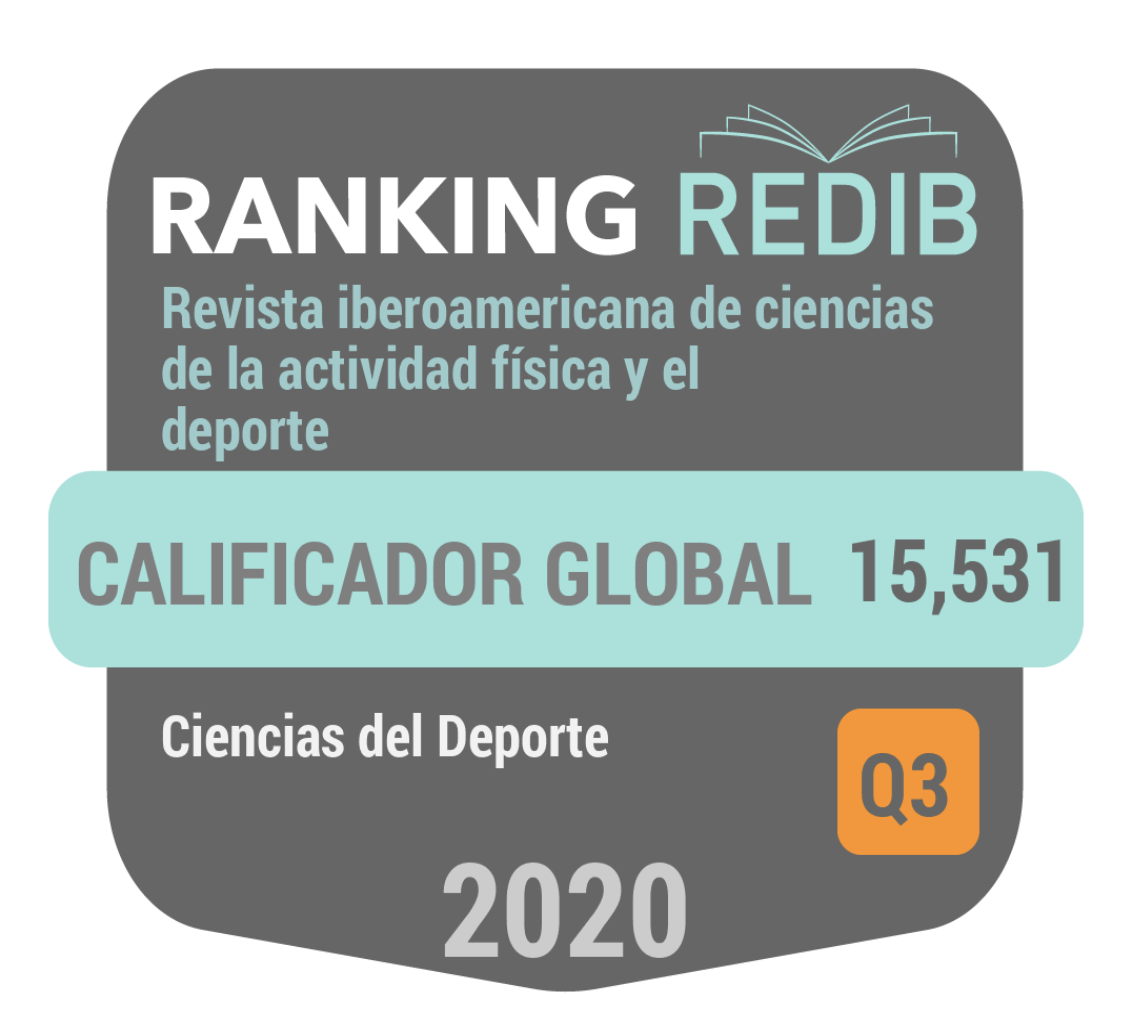Disfrute a través de una propuesta de descansos activos en educación infantil
DOI:
https://doi.org/10.24310/riccafd.2020.v9i1.8305Palabras clave:
descansos activos, disfrute, motivación, Educación InfantilResumen
La siguiente propuesta muestra un estudio que pretendió comprobar cuál es la influencia que tienen los descansos activos en el disfrute del alumnado de Educación Infantil, siendo este un elemento de la motivación. Además, se evaluó la existencia de diferencias en el disfrute en función del sexo del alumnado. Para ello, se llevó a cabo una metodología basada en los descansos activos durante diez días, en los cuales se recogieron las impresiones del alumnado a través de un test que se pasaba tras la actividad sedentaria, y, de igual forma, tras los descansos activos. Igualmente, se recogieron las impresiones por parte del profesorado a través de una entrevista realizada el último día del estudio. La muestra tomada para este trabajo constaba de 22 sujetos de una clase del primer curso del segundo ciclo de Educación Infantil (3 años), siendo estos 12 niñas y 10 niños. Finalmente, los resultados permitieron concluir que los descansos activos aumentan el disfrute del alumnado, sin que se den diferencias de acuerdo con la variable sexo.
Descargas
Métricas
Citas
Ryan, R.M., y Deci, E.L. (2000). Self-determination theory and the facilitation of intrinsic motivation, social development and well-being. American Psychologist, 55(1), 68-78. Recuperado de https://selfdeterminationtheory.org/SDT/documents/2000_RyanDeci_SDT.pdf
Davison, K.K., Werder, J.L., Trost, S.G., Baker, B.L., y Birch, L.L. (2007). Why are early maturing girls less active? Links between pubertal development, psychological well-being and physical activity among girls at ages 11 and 13. Social Science & Medicine, 64(12), 2391- 2404. Recuperado de https://www.ncbi.nlm.nih.gov/pmc/articles/PMC2067993/pdf/nihms25394.pdf
Fernández, E., Sánchez, B., y Salinero, J. J. (2008). Validación y adaptación de la escala PACES de disfrute con la practica de la actividad física para adolescentes españolas. Psicothema, 20(4), 890-895. Recuperado de http://www.psicothema.com/pdf/3571.pdf
Hashim, H., Grove, J. R. y Whipp, P. (2008). Validating the youth sport enjoyment construct in high school physical education. Research Quarterly for Exercise and Sport, 79(2), 183-194. Recuperado de https://www.researchgate.net/publication/23134637_Validating_the_Youth_Sport_Enjoyment_Construct_in_High_School_Physical_Education/download
Nahas, M.V., Goldfine, B., y Collins, M.A. (2003). Determinants of physical activity in adolescents and young adults. Physical Educator, 60(1), 42-56. Recuperado de https://www.researchgate.net/publication/235913873_Determinants_of_Physical_Activity_in_Adolescents_and_Young_Adults_The_Basis_for_High_School_and_College_Physical_Education_to_Promote_Active_Lifestyles
Subramanian, P.R., y Silverman, S. (2000). Validation of scores from an instrument assessing student attitude toward physical education. Measurement in Physical Education & Exercise Science, 4(1), 29-43. Recuperado de https://www.researchgate.net/publication/243666788_Validation_of_Scores_From_an_Instrument_Assessing_Student_Attitude_Toward_Physical_Education/download
Pérez López, J. A. (1991). Teoría de la acción humana en las organizaciones. Madrid: Ediciones Rialp.
Reeve, J. (1994). Motivación y emoción. Madrid: Mc Graw-Hill, 2-235.
Navarrete, B. (2009). La motivación en el aula. Funciones del profesor para mejorar la motivación en el aprendizaje. Revista digital. Innovación y experiencias educativas, 15, 2-3. Recuperado de https://archivos.csif.es/archivos/andalucia/ensenanza/revistas/csicsif/revista/pdf/Numero_15/BELEN_NAVARRETE_1.pdf
Sánchez, M., Gutiérrez, D., Ruíz de la Hermosa, A., López, C. y Sánchez, M.A. (2017). Proyectos Escolares Saludables. Descansos activos. Guía para profesores. Recuperado de https://ruidera.uclm.es/xmlui/bitstream/handle/10578/13451/Proyectos_escolares_saludables.pdf?sequence=1&isAllowed=y
Mitchell, J. (2016, 31 de octubre). GoNoodle Is Creating A World Where Kids Use Technology To Unplug. Forbes.
Moreno, J. A., González-Cutre, D., Martínez Galindo, C., Alonso, N., y López, M. (2008). Propiedades psicométricas de la Physical Activity Enjoyment Scale (PACES) en el contexto español. Estudios de Psicología, 29(2), 173-180.
Blanco, J. (2014). Evaluación de la motivación hacia el aprendizaje en niños de 2 a 3 años. International Journal of Developmental and Educational Psychology, 6(1), 259-266. Recuperado de https://www.redalyc.org/html/3498/349851790030/index.html
Suárez-Manzano, S., Ruíz-Ariza, A., López-Serrano, S. y Martínez, E. (2018) Descansos activos para mejorar la atención en clase: intervenciones educativas. Profesorado, Revista de Currículum y Formación del Profesorado, 22(4), 287-304. Recuperado de http://revistaseug.ugr.es/index.php/profesorado/article/view/8417/7151
Ruíz, J. R., Castro-Pinero, J., Artero, E. G., Ortega, F. B., Sjöström, M., Suni, J., y Castillo, M. J. (2009). Predictive validity of health-related fitness in youth: a systematic review. British journal of sports medicine, 43(12), 909-923. Recuperado de https://pdfs.semanticscholar.org/3d14/b38d6fe5525f8e938750777682766201a45a.pdf
Huang, T., Larsen, K. T., Ried-Larsen, M., Moller, N. C., y Andersen, L. B. (2014). The effects of physical activity and exercise on brain-derived neurotrophic factor in healthy humans: A review. Scandinavian Journal of Medicine & Science in Sports, 24(1), 1-10. Recuperado de http://doi.org/10.1111/sms.12069
Leckie, R. L., Oberlin, L. E., Voss, M. W., Prakash, R. S., Szabo-Reed, A., Chaddock- Heyman, L., y Erickson, K. I. (2014). BDNF mediates improvements in executive function following a 1-year exercise intervention. Frontiers in Human Neuroscience, 8, 12. Recuperado de https://www.researchgate.net/publication/269632144_BDNF_mediates_improvements_in_executive_function_following_a_1-year_exercise_intervention/download
Martínez-López, J., De la Torre-Cruz, M. J. y Ruíz-Ariza, A. (2018). Capítulo 1: “Active-Breaks”: una propuesta innovadora de descansos activos entre clases en Educación Secundaria. En P. Murillo y C. Gallego (Ed.), Innovación en la Práctica Educativa (pp. 13-19). Camas, Sevilla: Ediciones Egregius.
Descargas
Publicado
Cómo citar
Número
Sección
Licencia
Todos los contenidos publicados en Revista Iberoamericana de Ciencias de la Actividad Física y el Deporte están sujetos a la licencia Creative Commons Reconocimento-NoComercia-Compartirigual 4.0 cuyo texto completo puede consultar en <http://creativecommons.org/licenses/by-nc-sa/4.0>

Se pueden copiar, usar, difundir, transmitir y exponer públicamente, siempre que:
- Se cite la autoría y la fuente original de su publicación (revista, editorial y URL de la obra).
- No se usen para fines comerciales.
- Se mencione la existencia y especificaciones de esta licencia de uso.
Los derechos de autor son de dos clases: derechos morales y derechos patrimoniales. Los derechos morales son prerrogativas perpetuas, irrenunciables, intransferibles, inalienables, inembargables e imprescriptibles.
De acuerdo con la legislación de derechos de autor, Revista Iberoamericana de Ciencias de la Actividad Física y el Deporte reconoce y respeta el derecho moral de los autores/as, así como la titularidad del derecho patrimonial, el cual será cedido a la Universidad de Málaga para su difusión en acceso abierto.
Los derechos patrimoniales, se refieren a los beneficios que se obtienen por el uso o divulgación de las obras. Revista Iberoamericana de Ciencias de la Actividad Física y el Deporte se publica en open access y queda autorizada en exclusiva para realizar u autorizar por cualquier medio el uso, distribución, divulgación, reproducción, adaptación, traducción o transformación de la obra.
Es responsabilidad de los autores/as obtener los permisos necesarios de las imágenes que están sujetas a derechos de autor.
















9.png)
